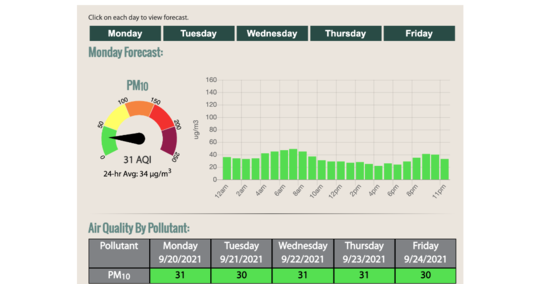ADEQ Expands Hourly Air Quality Forecasts
to More Arizona Communities — Including Rural Areas:
Douglas, Flagstaff, Hayden, Miami, Prescott & Rillito
PHOENIX (September 21, 2021) – ADEQ announced today new hourly air quality forecasts for communities in Douglas, Flagstaff, Hayden, Miami, Prescott and Rillito. These forecasts are based on the U.S. Environmental Protection Agency (EPA) Air Quality Index (AQI) and federal health standards. These new air quality forecasts are in addition to existing hourly AQI forecasts for Nogales, Phoenix, Tucson and Yuma. ADEQ air quality meteorologists issue hourly AQI forecasts five days a week, Monday through Friday, with each providing a five-day outlook.
“Expanding our air quality forecasts to more Arizona communities, including rural areas, is part of a systematic, statewide approach to provide all Arizonans with relevant air quality information for where they live and work,” said Daniel Czecholinski, ADEQ Air Quality Division Director. “Ensuring Arizonans have access to timely and accurate air quality forecasts is central to ADEQ’s mission to protect and enhance public health and the environment.”
For Douglas, Hayden, Miami and Rillito, ADEQ is forecasting the AQI value for Particulate Matter-10 (called PM-10 or dust). For Flagstaff and Prescott, ADEQ is forecasting the AQI value for Ozone.
View the New Hourly AQI Forecasts
- Douglas | View Forecast >
- Flagstaff | View Forecast >
- Hayden | View Forecast >
- Miami | View Forecast >
- Prescott | View Forecast >
- Rillito | View Forecast >
Learn more about these air pollutants:
Sample of ADEQ’s hourly AQI forecast:
 |
An AQI value of 100 for an air pollutant generally corresponds to EPA’s federal health standard for that pollutant — the level EPA set to protect public health. According to EPA’s AQI, pollutant levels with an AQI value at or less than 100 are considered satisfactory and values greater than 100 are considered to be unhealthy — at first for certain sensitive groups of people, and then for everyone as AQI values increase.
- Learn more about EPA’s AQI | View AQI Guide >
When ADEQ air quality meteorologists identify the potential for a forecasted pollutant to exceed the federal health standard (100 AQI), ADEQ will issue a High Pollution Watch (HPW). The HPW serves as an early outlook (up to five days) and provides people with advance notice of potential poor air quality — information they can use to make plans related to their work and outdoor recreation.
As the date of an issued HPW nears and additional data are available to strengthen the forecast analysis, if appropriate, ADEQ will upgrade the HPW to a High Pollution Advisory (HPA). ADEQ issues an HPA when exceedance of the federal health standard for a forecasted pollutant is imminent or there is a high probability.
Air Quality & Your Health
People most vulnerable to the impacts of air pollution include children, older adults, adults exercising outdoors, people with heart or lung disease and those suffering from asthma and bronchitis. Exposure can increase the number and severity of asthma attacks, cause or aggravate bronchitis or other lung disease and reduce the body’s ability to fight infection. Symptoms may include itchy eyes, nose, and throat, wheezing, coughing, shortness of breath, chest pain and upper respiratory issues.
Air Quality Forecasting & Alerts
- View all ADEQ Arizona air quality forecasts >
- Sign up to receive air quality forecasts and alerts by text or email >
- Download the Air Arizona Mobile App for Nogales, Phoenix, Tucson and Yuma for air quality forecasts, alerts and tips — the six new forecasts will be added in the future | Learn More >
Be Air Aware!
Together we can make a difference to improve air quality for everyone in Arizona. | Learn More >
###
Contact | ADEQ Public Information Officer
602-540-8072 | Email >
About ADEQ
Under the Environmental Quality Act of 1986, the Arizona State Legislature established the Arizona Department of Environmental Quality in 1987 as the state agency for protecting and enhancing public health and the environment of Arizona. For more information, visit azdeq.gov.
